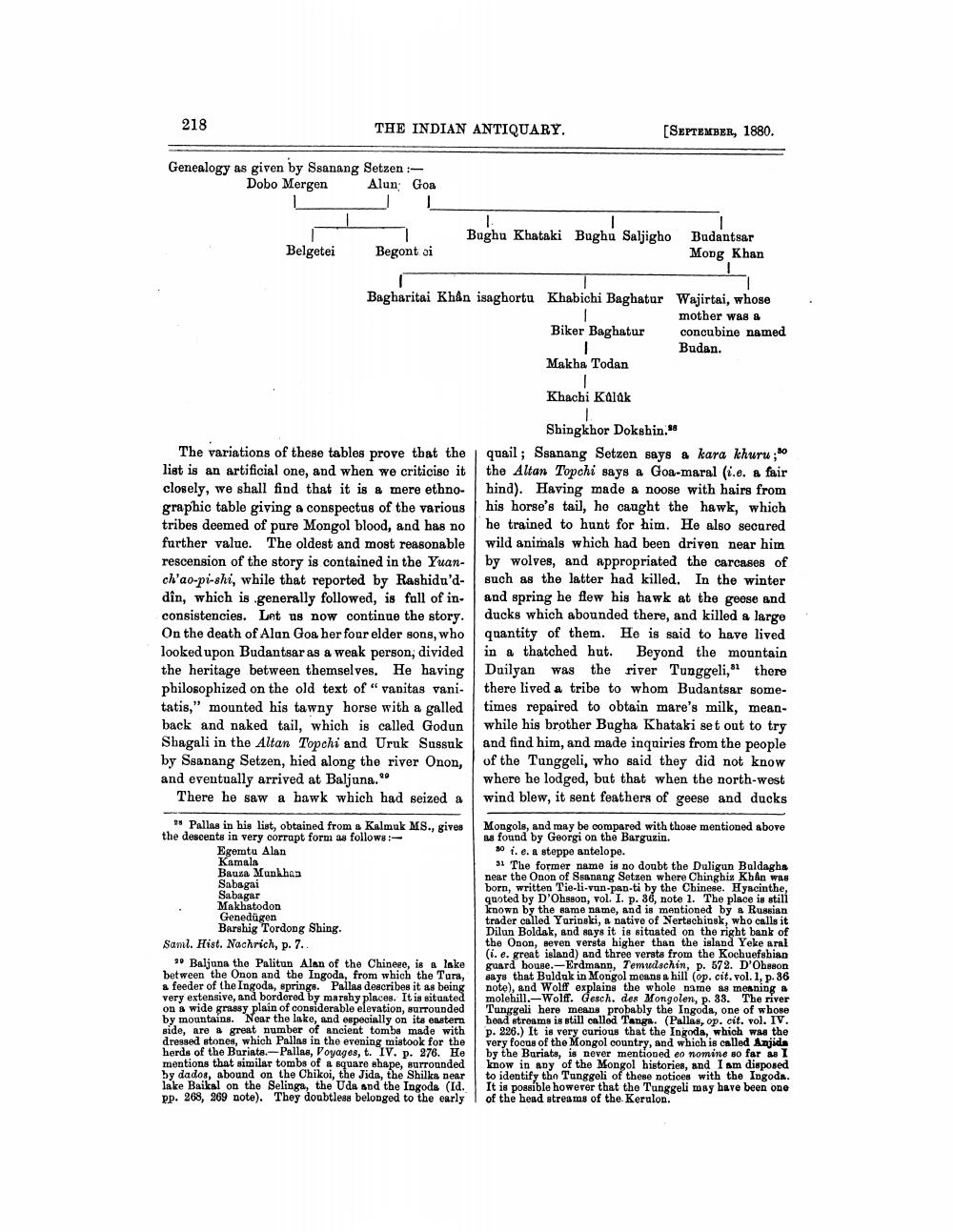________________
218
Genealogy as given by Ssanang Setzen :Dobo Mergen
Alun; Goa I
Belgetei
Egemtu Alan
Kamala
THE INDIAN ANTIQUARY.
The variations of these tables prove that the list is an artificial one, and when we criticise it closely, we shall find that it is a mere ethnographic table giving a conspectus of the various tribes deemed of pure Mongol blood, and has no further value. The oldest and most reasonable rescension of the story is contained in the Yuanch'ao-pi-shi, while that reported by Rashidu'ddîn, which is generally followed, is full of inconsistencies. Let us now continue the story. On the death of Alan Goa her four elder sons, who looked upon Budantsar as a weak person, divided the heritage between themselves. He having philosophized on the old text of "vanitas vanitatis," mounted his tawny horse with a galled back and naked tail, which is called Godun Shagali in the Altan Topchi and Uruk Sussuk by Ssanang Setzen, hied along the river Onon, and eventually arrived at Baljuna.""
There he saw a hawk which had seized a
Bauza Munkhan
Sabagai
Sabagar
2 Pallas in his list, obtained from a Kalmuk MS., gives the descents in very corrupt form as follows:
Makhatodon
Genedügen
Barshig Tordong Shing.
Begont si
Saml. Hist. Nachrich, p. 7..
[SEPTEMBER, 1880.
I
Bughu Khataki Bughu Saljigho
Bagharitai Khan isaghortu Khabichi Baghatur Wajirtai, whose 1 mother was a concubine named Budan.
Biker Baghatur
I
Makha Todan
T
Khachi Külük
29 Baljuna the Palitun Alan of the Chinese, is a lake between the Onon and the Ingoda, from which the Tura, a feeder of the Ingoda, springs. Pallas describes it as being very extensive, and bordered by marshy places. It is situated on a wide grassy plain of considerable elevation, surrounded by mountains. Near the lake, and especially on its eastern side, are a great number of ancient tombs made with dressed stones, which Pallas in the evening mistook for the herds of the Buriate.-Pallas, Voyages, t. IV. p. 276. He mentions that similar tombs of a square shape, surrounded by dados, abound on the Chikoi, the Jida, the Shilka near lake Baikal on the Selinga, the Uda and the Ingoda (Id. pp. 268, 269 note). They doubtless belonged to the early
T
1
Shingkhor Dokshin,
Budantsar Mong Khan I
quail; Ssanang Setzen says a kara khuru;0 the Altan Topchi says a Goa-maral (i.e. a fair hind). Having made a noose with hairs from his horse's tail, he caught the hawk, which he trained to hunt for him. He also secured wild animals which had been driven near him by wolves, and appropriated the carcases of such as the latter had killed. In the winter and spring he flew his hawk at the geese and ducks which abounded there, and killed a large quantity of them. He is said to have lived in a thatched hut. Beyond the mountain Duilyan was the river Tunggeli, there there lived a tribe to whom Budantsar sometimes repaired to obtain mare's milk, meanwhile his brother Bugha Khataki set out to try and find him, and made inquiries from the people of the Tunggeli, who said they did not know where he lodged, but that when the north-west wind blew, it sent feathers of geese and ducks
Mongols, and may be compared with those mentioned above as found by Georgi on the Barguzin.
30 i. e. a steppe antelope.
31 The former name is no doubt the Duligun Buldagha near the Onon of Ssanang Setzen where Chinghiz Khan was born, written Tie-li-van-pan-ti by the Chinese. Hyacinthe, quoted by D'Ohsson, vol. I. p. 36, note 1. The place is still known by the same name, and is mentioned by a Russian trader called Yurinski, a native of Nertschinsk, who calls it Dilun Boldak, and says it is situated on the right bank of the Onon, seven versta higher than the island Yeke aral (i. e. great island) and three versts from the Kochuefshian guard house.-Erdmann, Temudschin, p. 572. D'Ohsson says that Bulduk in Mongol means a hill (op. cit. vol. 1, p. 36 note), and Wolff explains the whole name as meaning at molehill.-Wolff. Gesch. des Mongolen, p. 33. The river Tunggali here means probably the Ingoda, one of whose head streams is still called Tanga. (Pallas, op. cit. vol. IV. p. 226.) It is very curious that the Ingoda, which was the very focus of the Mongol country, and which is called Anjida by the Buriats, is never mentioned eo nomine so far as I know in any of the Mongol histories, and I am disposed to identify the Tunggeli of these notices with the Ingoda. It is possible however that the Tunggeli may have been one of the head streams of the Kerulon.




